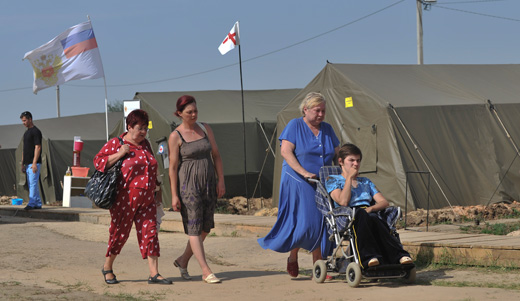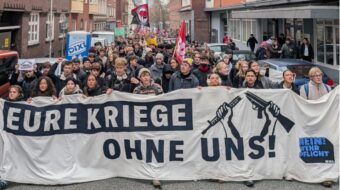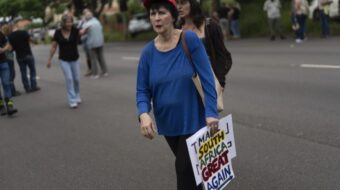
According to reports today, two Ukrainian military aircraft have been shot down over the Eastern Ukraine. This latest incident comes only days after the shooting down July 17 of a Malaysian airliner over the area and the resulting deaths of 298 innocent persons. As today’s events show, the deaths of the 298 people shot out of the sky last week will be a source of tension for some time. Incidents of this type sometimes require years before the full story comes to light.
Various people with their own agendas continue to push their versions of who is to blame. The United States has now backed away from directly accusing Russia, but points at dissident militias. Russia, for its part, has raised questions about Ukrainian air force jets that it says were in the vicinity of Malaysian Airlines flight MH 17 when it was knocked out of the sky.
Meanwhile, there is a shooting war in Eastern Ukraine between military forces under the control of Ukrainian President Petro Poroshenko, and local militias who reject the Poroshenko government and respond to the orders of the Donetsk and Luhansk “Peoples Republics.”
At first, Ukrainian military forces sent by the Kiev government to crush any resistance to its control in the east suffered from defeats, surrenders and defections. But after Petro Poroshenko was elected president (in a highly questionable election lacking meaningful voter participation in huge swaths of the country) on May 25, the tide began to turn.
Part of the reason the Kiev government was able to reverse defeats on the battlefield was its willingness to rely on the help of extreme right-wing militia groups. One of these groups, the Right Sector, had played a major role in the violence in Kiev itself back in February. Their leader, Dmitryo Yarosh, has been seen on the battlefront in the east with the Azov Battalion. The Azov Battalion fights in cooperation with Ukrainian government forces under the patronage of Interior Minister Arsen Avakov, himself an extreme right winger who is a major figure in the drive to ban the Communist Party of Ukraine as well as the Party of the Regions.
In the past, the Communist Party of the Ukraine and the Party of the Regions are the two parties that have had the most electoral support in Eastern Ukraine.
Azov Battalion leaders are known for their racist and extremist rhetoric, and are feared by the majority Russian-speaking population in Eastern Ukraine. They are believed to have played a key role in the violent capture, by the Kiev forces, of the cities of Slavyansk and Kramatorsk over the 4th of July weekend. There were reports of many civilian casualties.
There are also indications that Right Sector forces were behind the massacre in Odessa on May 2, in which at least 41 opponents of the Kiev government were burned, suffocated and beaten to death after they were trapped in the Trade Union Hall.
Poroshenko and his officials, including Andriy Parubiy, another right wing extremist official who is coordinating the military action in the East, have refused to negotiate with the dissident forces in Luhansk and Donetsk, claiming that they are “terrorists” and “animals” under the control of Russia. They call for “revenge’ for the loss of lives of soldiers. There is reported to be a massing of forces for a full attack on Donetsk and Luhansk, cities of 1 million and 425,000 people respectively. Shelling and bombing have already reached Luhansk and the suburbs of Donetsk. Air raids followed by street-by-street fighting could ensue.
A half million refugees, fearing for the safety and lives of their families, have already crossed into Russia. At least five Ukrainian military aircraft have been shot down, with fatalities.
The General Secretary of the Communist Party of Ukraine, Petro Symonenko, has called for a full and impartial investigation of the shooting down of the airliner, as have Russian President Putin, the United Nations Security Council and many others. The Ukrainian Communists’ position has been for a united Ukraine with a federal system to protect the rights of minorities, but Kiev nevertheless accuses it of being pro-Russian and “separatist”. On Tuesday, the Kiev Parliament, the Rada, voted to ban the Communist Party faction. (This decision has to be ratified in the courts).
On Tuesday also, a violent brawl broke out on the floor of the Rada, when Poroshenko narrowly won a vote authorizing the calling up military reserves to face a supposed Russian threat. One of the remaining deputies from the Party of the Regions denounced the killing of civilians in Eastern Ukraine, and a fistfight was started by ultra-right deputies, including the well-known Svoboda Party goon Igor Miroshnichenko.
The United States, NATO and the European Union see this struggle as a fight to bring Ukraine under their sway, and out of the orbit of Russia. In play are questions of trade, geopolitics and access to fossil fuels. The Kiev regime, the key ally of these “Western” forces, is, however, playing with fire by allying with neo-Nazis for the purpose of crushing resistance by people in Eastern Ukraine. Top officials such as Prime Minister Arseny Yatsenyuk are opportunists, not ideologues. Eventually they will clash with the neo-fascist forces who are not “pro Europe” and are, many of them, anti-Semites. Remember General von Schleicher? [German Chancellor during the Weimar Republic, he was assassinated in 1934 by order of his successor, Adolf Hitler, in the Night of the Long Knives.]
Russian President Vladimir Putin has been denouncing the way ethnic Russians and Russian-speaking Ukrainians are treated by Kiev, but fails to mention that the government in Kiev will prove no friend of ethnic Ukrainians either, once it pursues its line of integrating this poorest of European countries with the European Union. So he too is playing a “national” card.
We in the U.S. should demand that our government, which has heavily supported the Kiev regime, back away from its hard line position, and call for negotiations, not just between Kiev and Moscow but between Kiev and Donetsk also.
And there should be no truck with neo-Nazis, or support for a government that includes them.
Photo: At a camp for refugees from Ukraine’s east, on the border with Ukraine near the Russian town of Donetsk in Rostov-on-Don region, July 13. A half million refugees, fearing for the safety and lives of their families, have already crossed into Russia. Sergei Pivovarov/AP










